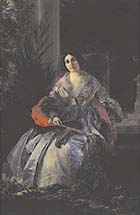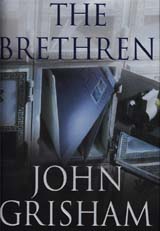Legacy Unveiled: Stroganoff
Kimbell hosts art works of Russian noble family
By Michael Davis
staff reporter
Only rarely does an art exhibition cover a large fraction of history, consist of quality and demonstrate the power, opulence and grandeur of the family who collected it. “Stroganoff: The Palace and Collections of a Russian Noble Family” is such an exhibit.
 “It’s
not a single piece (that makes the exhibit special), but the quality of
the whole collection,” said Baroness Helene de Ludinghausen, a Stroganoff
descendant, during the taped tour at the Kimbell Art Museum.
“It’s
not a single piece (that makes the exhibit special), but the quality of
the whole collection,” said Baroness Helene de Ludinghausen, a Stroganoff
descendant, during the taped tour at the Kimbell Art Museum.
The collection doesn’t focus on a specific time period, but instead contains more than 230 works collected by the Stroganoffs from the late 1500s through the early 1900s. The exhibit will be on display through Oct. 1.
Timothy Potts, director of the Kimbell, said the Stroganoff collections were dispersed in 1917 after the Bolshevik Revolution.
“This exhibition brings them together for the first time in over 70 years and recreates the grandeur that was synonymous with the name Stroganoff,” he said.
As visitors enter the exhibit, they are confronted with portraits of Catherine the Great and Peter the Great, founder of St. Petersburg, Russia. Close ties to these Russian rulers enabled Alexander Stroganoff and others in his family to not only amass a great fortune, but also large amounts of art. The Stroganoffs were incredibly wealthy from their exploits in Siberia and eventually supplied 20 percent of all the taxes in Russia. A Russian proverb says, “Richer than the Stroganoffs you’ll never be.”
One example of the beneficial relationship between the czars and the Stroganoffs is illustrated by the magnificent 12-foot-long scroll written in Cyrillic text and decorated in crimson taffeta and gold brocade. The “Charter of Czars Ivan Alexeievich and Peter Alexeievich to Grigory D. Stroganoff” enumerates the land grants, mineral rights and privileges bestowed on the Stroganoffs by the Imperial family.
Religious themes permeate much of the exhibit. There is a beautiful collection of icons from Stroganoff churches that help explain complex theological ideas.
Stroganoff women served as an integral part in the creation of many of
the exhibit’s religious shrouds. They directed and sewed several
on display at the Kimbell, and lent their own particular style to the
art.
One of the most striking examples of the Stroganoff family’s dedication
to art is exhibited by the “Malachite Coupe.” The radiant green
bowl-shaped stone is supported by three bronze-gilded women and stands
several feet high. This is the first time it has left Russia since it
was created in 1810.
The stone work exhibited by artists employed at Stroganoff stone-cutting facilities shows incredible skill and talent, although some pieces may not be too striking in appearance. Some of the most interesting but subdued examples of exquisite stone-working are the vodka cups and tray. Their paper-thin edges testify to the expertise of Stroganoff’s artisans.
One unimposing but historical sketch by Andrei Voronikhin shows a sketch of a monument to commemorate the 1812 victory of the Russian army over Napoleon. Although never realized, the drawing exemplifies how intertwined the Stroganoffs were in Russia’s history and politics.
As you exit, the extraordinary “Portrait of Her Highness Elizabeta Saltykova” bids you farewell, and you hear Ludinghausen with her husky voice say, “It is my hope that a new generation will take up the task of preserving the beauty of the past in a way that speaks clearly to the present and the future.”
The Stroganoff exhibit is organized by the State Russian Museum, the State Hermitage Museum and the Portland Art Museum in Oregon.
Fort Worth and Portland are the only American venues to host this exhibition, which will travel to Paris before completing its international tour at the Hermitage Museum in St. Petersburg.
Michael Davis
m.s.davis@student.tcu.edu
Eve 6 - Horrorscope
CD Review
Eve 6 are like the protagonists of their own songs. They desperately want you to like them. The opening song on their new album “Horrorscope” almost convinces the listener that this could be a possibility.
The first 30 seconds of “Rescue” are a joyous shot of ‘70s
rock: all synthesizers and screaming.
But just as fast as they go glam, they turn around and head right back
to the warm bosom of bland modern rock the second Valley Boy lead singer
Max Collins opens his mouth.
 “I
wanna ditch the logical,” Collins announces during the string-soaked
“Here’s to the Night.” He manages to generate more than
his share of eyebrow-raising clunker song lyrics — such as “like
Jessica Rabbit she collects bad habits” and “we’re out
of here like Vladimir.” Could this be a Nabokov reference? Doubtful.
They may be precocious, but Eve 6 is a lot less smart than they let on.
“I
wanna ditch the logical,” Collins announces during the string-soaked
“Here’s to the Night.” He manages to generate more than
his share of eyebrow-raising clunker song lyrics — such as “like
Jessica Rabbit she collects bad habits” and “we’re out
of here like Vladimir.” Could this be a Nabokov reference? Doubtful.
They may be precocious, but Eve 6 is a lot less smart than they let on.
“Horrorscope” is a producer’s album — which in this case is not a very good thing. The 12 tracks on the album veer gracelessly from tough-guy power-chord punk to overproduced New Wave. The former sounds too uninspired; the latter just seems like overcompensation for the weak musicianship of the band. The synth effects are the musical equivalent of adding mayonnaise to a plain ham sandwich — it might taste a little different than before, but it’s not filet mignon.
Every song on “Horrorscope” is basically the same. Guy has a girlfriend who causes him grief, but she’d better stick around because the sex is good. All the while guitars mucking around in mid-tempo bring the background noise.
All 12 tracks have single potential, but judging by the state of modern-rock radio, this should be taken as a warning, not an invitation.
“This is the last song I’ll send your way,” Collins bellows amid the drone of grumbling guitars and laser beams on “Amphetamines.” The line is delivered with a customary ironic smirk. But when you consider the average shelf life of a modern rock band and the overall flatness of “Horrorscope,” this might be a very dire prediction instead.
— Jack Bullion
Convicts scheme to make millions a novel idea
Grisham’s new book introduces audiences to yet another captivating thriller
Book Review
By Christina Hager
Skiff staff
“The Brethren” is the newest novel by the national best-selling
author John Grisham.
The book narrates two seemingly unrelated plots. The first is that of
the “Brethren,” a group of three ex-judges who live and work
together in the federal prison called Trumble. The three are from different
backgrounds and are all indicted for different crimes.
 The
first, Hatlee Beech, a former federal judge, was convicted of drunken
driving and the involuntary manslaughter of two college students. Joe
Roy Spicer, the least educated of the three, met his downfall when he
was caught skimming profits from local Shriner bingo games. Lastly, there
is Finn Yarber, a former California Supreme Court justice convicted of
tax evasion.
The
first, Hatlee Beech, a former federal judge, was convicted of drunken
driving and the involuntary manslaughter of two college students. Joe
Roy Spicer, the least educated of the three, met his downfall when he
was caught skimming profits from local Shriner bingo games. Lastly, there
is Finn Yarber, a former California Supreme Court justice convicted of
tax evasion.
To the warden, guard and fellow inmates, the judges are respected and left to their privacy. Once a week, they hold an informal, yet very serious court where affairs between prisoners are settled. The Brethren is the law of the land — appeals are not allowed.
However, when the doors to the prison law library close, the Brethren have something other than the law on their minds. They are working on a letter-writing extortion scheme designed to make them millionaires by the time they leave the prison.
The second plot of the book chronicles Congressman Aaron Lakeneed, who is on a crusade to win the presidential race based on one platform: increasing national defense. Backed by top-secret support and a never-ending supply of funds from the CIA, this is one race Lakeneed is guaranteed to win.
Grisham’s book moves at a fast pace, but unlike many other lawyer-written books, it does not lose you in the author’s attempt to illustrate his overwhelming knowledge of the subject at hand.
His latest piece is free from the usual trial fever and novice-lawyer-who-somehow-saves-the-day bravado he has become known for. Instead, the book depicts several realistic political and social ideas. Grisham also takes a more international perspective in his novel, letting the plot flow onto different continents.
This is Grisham’s most mature book, written with a different tone from his former bestsellers. Filled with intrigue, suspense and political concepts, this is Grisham’s best bedtime story and a necessary read for any Grisham fan.
Christina Hager
ctinasing2000@aol.com
Croupier
Movie Review
When you find yourself in a small theater, with less-than comfortable seats and a tiny screen, what you’re probably watching is an independent film. But “Croupier,” a British movie originally released in 1997, is worth forgoing all the comforts normally afforded to big-budget Hollywood blockbusters.
Clive Owen plays Jack Manfred, an aspiring but broke writer in need of a job and a steady paycheck. But when his dad lands him a position as a dealer (or “croupier” as the Brits say) in a small-time casino, he is initially reluctant. It seems that Jack has worked in this field before, and while his skill as a croupier is among the best, writing remains his top priority.
Nevertheless, Jack re-enters the gambling world and gradually begins breaking all the rules, including discussing a robbery with one of his gamblers (or “punters”). But “Croupier” is more than just a well-told tale of a thrilling heist. Working in the casino creates new excitement in Jack’s life, spurring his writing and changing his world forever.
This is a smart, well-made film that distinguishes itself from the rest of the hackneyed summer movie crowd. Not only does it explore the relationship between dealer and gambler and between writer and subject, but it still manages to maintain the strength of the plot. Although it does drag at parts, “Croupier” is definitely the best movie I’ve seen in months. Check it out soon, because there’s no telling how long this independent release will last. Not rated, with language, mild violence and nudity. Showing in Ft. Worth exclusively at Hulen 10.
— Josh McDonald